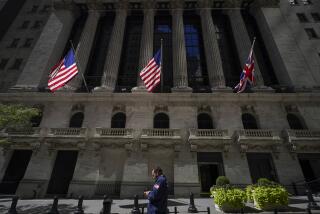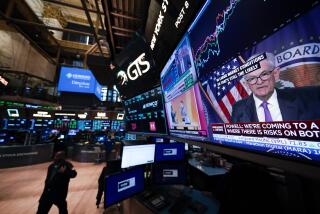Dollar’s Fall Is Both Boon and Setback
- Share via
NEW YORK — The dollar, strongman of world currencies for most of the last six years, has dropped 9% against the euro since early July, cheering both U.S. manufacturers and European politicians--but unnerving some global investors.
The dollar also has eased against the Japanese yen, despite continued economic woes in Japan.
The dollar’s mini-downtrend, breaking months of trading momentum in its favor, has led some traders and investors to wonder whether the Bush administration has quietly reversed the staunch strong-dollar policies of its predecessors.
A falling dollar could help U.S. exporters by making their goods cheaper overseas, and thus could firm up U.S. manufacturing employment.
Some European politicians favor a weaker dollar, and stronger euro, because that shift boosts Europeans’ purchasing power.
But a sinking dollar also raises the cost of imported products for American consumers--threatening higher inflation.
Yet even before the implications of a weaker dollar can be fully absorbed, many analysts believe that the currency will strengthen again. Such experts see signs--faint but encouraging--of a pickup in the U.S. economy, while Europe and Japan appear headed into deeper slowdowns.
Some economists also argue that although falling U.S. interest rates and stock prices, and European politicians’ desire to bolster their currency, may be a drag on the dollar in the near term, the relative strength of the U.S. economy will trump other factors in the long run.
“I wouldn’t touch the euro with a barge pole,” said Ian Shepherdson, British-born chief U.S. economist at High Frequency Economics in Valhalla, N.Y.
The euro closed at 91.4 cents Thursday in New York, up slightly from Wednesday and up from a recent low of 83.6 cents July 5. The modest rebound still leaves the multinational currency far below its all-time peak of $1.18 hit just after it was introduced in January 1999.
The yen, meanwhile, closed at 119.93 per dollar, nearly 5% stronger than its early-July level of 125.87.
Continuing strength in U.S. housing and improving consumer confidence about the future help convince Shepherdson that the U.S. economy is at or near a turnaround, while Europe and Japan seem likely to weaken further, he said.
Economic fundamentals, however, don’t necessarily determine the direction of a currency in the short run. Changes in exchange rates can result from activities of traders in the currency market, which, in terms of sheer value of daily trading, is bigger than the stock market.
Currency traders respond to changes in global money flows, such as when Japanese or German investors decide to pull back from Wall Street and bring money back home. Traders also respond to rumors of policy shifts, and they now have their ears open wide for any hint that the White House might relax support for the dollar.
The Bush administration has been getting pressure in that direction. General Motors Corp., to name one giant manufacturer, has complained publicly that the strong dollar gives its foreign competitors a price advantage here and abroad. Other manufacturers are sending the same message more quietly, analysts said.
If there were a policy change, traders probably would stampede out of the dollar, said Scott E. Pardee, professor of monetary economics at Middlebury College in Vermont and a former official of the Federal Reserve Bank of New York.
That is why some global investors worry about the dollar’s recent shift: They fear it could trigger massive selling of U.S. stocks and bonds by foreigners who see the value of their holdings depreciate with each slide in the currency.
So far, though, the White House hasn’t budged overtly from the position staked out by Treasury Secretary Paul H. O’Neill at a news conference in Palermo, Italy, last February: “I believe in a strong dollar, and if I decide to shift that stance, I will hire out Yankee Stadium and some rousing brass bands and announce that change in policy to the whole world,” he said.
In any case, GM is misplacing the blame, according to James E. Glassman, senior economist at J.P. Morgan Securities in New York.
“It’s not so much the [strong] dollar as that our trading partners are sucking wind,” Glassman said. Europeans are feeling the pinch from their own economic slowdown, and Japanese consumers aren’t buying much of anything, even if they were inclined to buy American goods, he said.
European politicians favor a stronger euro partly for national-pride reasons. The common currency’s value has declined for most of its nearly three-year history.
As Jan. 1 approaches, when local coins and bills in the 12-nation euro zone will finally be replaced by euros, many Europeans are disgruntled about abandoning national currencies that date to the reign of Charlemagne in favor of an upstart--and, so far, a wimpy one at that.
Thus, the European Central Bank may be reluctant to lower interest rates as quickly as the Continent’s eroding economic picture seems to warrant, at least for the rest of this year, said economist William E. Rhodes of Rhodes Analytics in Boston. Lower rates could hurt the euro.
Meanwhile, Federal Reserve policymakers meet Tuesday, and most analysts expect the central bank to cut its key short-term interest rate for the seventh time this year, this time from 3.75% to 3.50%.
All things being equal, Fed rate cuts tend to weaken the dollar by lowering the return on dollar-denominated assets. However, few experts believe that the recent slide in the dollar, so far relatively modest, will keep the Fed from ordering another rate cut.
(BEGIN TEXT OF INFOBOX / INFOGRAPHIC)
Euro Bounce
The euro currency’s value has rebounded above 91 cents from under 84 cents in early July, but it remains far below its level when introduced in 1999.
Thursday: 91.4 cents
Source: Bloomberg News
(BEGIN TEXT OF INFOBOX / INFOGRAPHIC)
Europe Gets More Expensive
The euro’s rebound has made Europe more expensive for U.S. tourists. Here’s a look at what $1 was worth in the 12 individual euro-zone currencies July 5 and the values Thursday.
*--*
Currency per $1 Country Currency July 5 Thursday Germany mark 2.34 2.14 France franc 7.84 7.18 Italy lira 2,314.00 2,121.00 Netherlands guilder 2.64 2.14 Spain peseta 199.10 182.30 Portugal escudo 239.90 219.60 Finland markka 7.11 6.51 Ireland punt 0.94 0.86 Austria schilling 16.46 15.08 Belgium franc 48.25 44.06 Luxembourg franc 48.25 44.06 Greece drachma 407.70 373.20
*--*
Note: These exchange rates are for very large transactions.
Source: Associated Press
More to Read
Inside the business of entertainment
The Wide Shot brings you news, analysis and insights on everything from streaming wars to production — and what it all means for the future.
You may occasionally receive promotional content from the Los Angeles Times.










